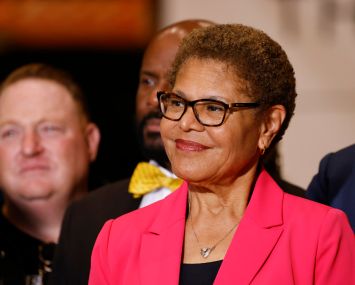NYC Hit Record for Subsidizing Affordable Housing in 2023, Adams Says
By Abigail Nehring January 19, 2024 3:32 pm
reprints
New York City developers broke ground on a record number of subsidized affordable homes in 2023, according to figures Mayor Eric Adams released Thursday in a bid to get Albany to step up its game on housing legislation this year.
City housing officials signed off on tax breaks, bond financing and other subsidy applications for 14,227 new affordable units in 2023, surpassing the city’s previous record of 12,117 units in 2021, according to Adams. That also puts 2023 well above the annual average of 9,366 units over the past decade.
However, the number of deals that permanently preserved existing affordable units was slightly less impressive, with 13,684 affordable units preserved in 2023, below the 10-year average of 15,505 units per year.
Combining the two categories, the total number of affordable housing units that got the green light for public financing last year shot up 80 percent year-over-year in 2023, according to the figures in the mayor’s announcement. The numbers have not yet been published publicly, and the city did not provide dollar amounts for the subsidies awarded.
“I have to use what I have to move the ball down the field, and we moved that darn ball down the field this year,” Adams said Thursday in a press briefing laden with football metaphors.
Despite a record-breaking 2023, New York City’s housing shortage still dwarfs the progress the city has made to subsidize affordable units.
A majority of New York City households are rent-burdened, and a third of residents spend more than half of their income on rent, according to a study published in October by the Community Service Society of New York, a charity and public policy research organization.
Plus, multifamily construction has slumped over the past two years thanks to rising inflation and the increased cost of borrowing for developers.
The city’s power to spur housing development rests with the New York City Department of Housing Preservation and Development (HPD) and the New York City Housing Development Corporation (HDC). The agencies administer several local, state and federal subsidies to incentivize affordable housing construction, including the 421a state tax abatement, which Gov. Kathy Hochul unsuccessfully tried to revive after it expired in 2022.
“We have to build our way out of this. We can’t say that enough,” Adams said. “We need to put in place an extension — at a minimum — for 421a, and we must come up with a real way of moving forward.”
Aside from the loss of 421a — which many in real estate say is vital to make the numbers for affordable housing development work — it became significantly harder for developers to make it through the administrative gantlet during the pandemic, thanks to double-digit vacancies at city agencies.
That has slowly started to change as the city has filled those roles, which HPD said is part of the reason for the record number of subsidy approvals in 2023.
“We’ve done a lot of hiring that helped us reach these new highs,” a spokesperson for HPD said. “That’s part of it, as well as finding new creative ways to do whatever it takes to get the housing we need.”
Yet, last year’s progress may be undone as Adams proposed cuts to the city’s Housing Capital Commitment Plan. The mayor also wants to slash HPD’s capital budget from $2.7 billion to $2.1 billion as part of his preliminary financial plan released Tuesday.
Another problem could be the continued lack of a replacement for 421a. The tax abatement helped finance more than half of the new multifamily units that started construction last year, according to Adams.
Though popular with developers, critics contend that 421a failed to help New Yorkers who need it the most, since it gave generous tax breaks to developers who rented to families that made as much as 130 percent of the area median income (AMI).
The federal government sets the AMI for the entire New York metro area, which means a family of three earning roughly $150,000 per year would meet that requirement, said Emily Goldstein, director of nonprofit research and advocacy organization the Association for Neighborhood & Housing Development.
“We’re paying a lot of attention to not just numbers but the level of affordability,” Goldstein said. “That’s not what most of us are talking about when we talk about affordable housing.”
Earlier this week, Hochul laid out her proposal for the next version of 421a, which would be called 485x “Affordable Neighborhoods for New Yorkers.” It would provide developers a similar tax break as its 421a predecessor but would give HPD more control over the mix of affordable and market-rate units the projects must contain, along with the household income requirements tenants must meet, as Crain’s New York Business reported.
In the meantime, she also proposed extending the deadline for ongoing developments to take advantage of 421a if it finishes construction by 2031.
However, state lawmakers rejected Hochul’s attempt last year and shot down a similar deadline extension for 421a.
Despite 421a’s shortcomings, Brendan Cheney, policy director for the nonprofit think tank the New York Housing Conference (NYHC), said his group found that it reaches more affluent neighborhoods that often won’t get affordable projects that rely on other types of public subsidies.
“421a is generating units in neighborhoods that HPD isn’t reaching because of land costs,” said Cheney. “HPD subsidies generate units in low-cost and low-income neighborhoods, whereas 421a is spurring growth in more expensive, high-density neighborhoods.”
To keep the positive momentum on new affordable housing construction, Cheney added it’s imperative for the state to pass a replacement.
“The new construction numbers are moving in the right direction,” Cheney said. “But in order to maintain it, we need a new tax incentive in Albany and more capital funding for housing in the city budget.”
Abigail Nehring can be reached at anehring@commercialobserver.com.


